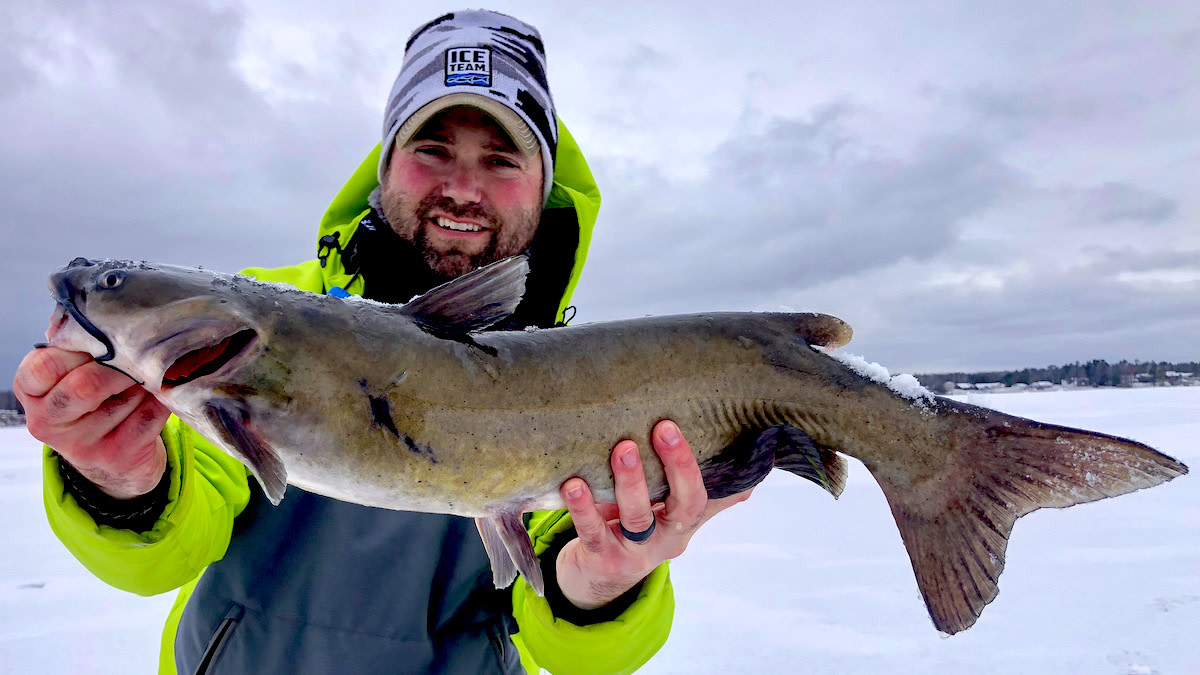
Anglers across the United States spend a lot of time fishing for catfish, but that sure isn’t the case when it comes to ice fishing. More than likely this is because so many of the diehard cat chasers are located in the southern parts of the country that don’t usually freeze, unlike this year. Regardless, hardwater catfish are like the Rodney Dangerfield of ice fishing, they could use a little respect. Catfish are abundant, delicious, hard fighting, and in most cases aren’t as picky as other frequently-chased ice species. If there’s a catch, it’s that most anglers don’t know where to start to looking for catfish. Pro ice angler Matt Johnson specifically guides for hardwater cats and shared with me his top five places to start your search.
Steep Breaks
Sharp dropoffs leading to deep water may sound like a great spot for fish of all species, but this feature is especially valuable for catfish. In many cases, these breaks are the same ones that walleyes or crappies tend to congregate on, but just deeper. When you locate a given depth holding catfish, look to follow that same depth along the break. Catfish tend to use those contours almost like roadways. According to Johnson, don’t lock a certain depth into your head until you locate catfish because many aren’t as deep as you would think on these steep breaks. When in doubt look for a bottom composition change—catfish are suckers for that.
Deep Holes
When you think of traditional catfish hiding places, deep holes are probably the first thing to come to mind. Johnson cautions anglers to realize that “deep” is a relative term. On one body of water, deep may mean 20 feet, while it may mean 60 feet on another. On lakes with a max depth of less than 30 feet, Johnson will typically look at the deepest spots as his first stops. Deep holes on relatively shallow lakes are consistently used as wintering grounds by large numbers of catfish. With that said, Johnson admits he generally doesn’t catch many catfish deeper than 40 feet.
Neck-Downs
Neck-downs are narrow points on a particular contour or channel. These natural funnels are prime locations to intercept winter kitty fish. According to Johnson, “These spots can corral catfish in a certain area. As the fish move around the edge of a basin or hole, cats will stack in these spots. Catfish will act much like other species and locate around turns and bends in contour.”
A quick way to locate these neck-downs before even hitting the lake is to use depth highlighting on your navigational charts. On a traditional map or even digital mapping it can be hard on the eyes to see these spots mixed among all of the other contours until some color is added. Highlight a depth you like and look for thin spots in that line. This also makes it much easier to quickly find other similar locations in other parts of the lake.
Current
It’s no secret that catfish like current, or at least to be in close proximity to current. It’s also no secret that current and poor ice conditions go hand in hand. On frozen water directly fed by a river, it’s likely that catfish will be nearby. While it is often too unsafe to target them on or near the river channel, Johnson likes to fish the lake portion of the reservoir or lake where the current washes out or eddies. These areas can hold some of the largest populations of wintertime cats and can still be fished safely. When you’re out on any of these areas, ice safety needs to be the first priority. Remember that current eats ice.
Deep Mud
Catfish are notorious for loving deep muddy bottoms, and the winter months are often no exception. Punching a bunch of holes in these areas is often necessary because catfish tend to roam on this type of substrate and sitting in one spot too long can be a big mistake. Johnson was quick to point out that it’s not uncommon to catch catfish with silt or mud all over their bellies.
It may sound obvious, but when fishing deep mud you need to make sure the lake you are targeting has a healthy population of catfish to reduce bycatch. “Some of our transition lines we like to target for perch and walleye can hold a lot of catfish as well, so just remember you need to focus on lakes with a good population of catfish,” Johnson said.
The whiskered fishes may not be on the top of anyone’s ice fishing to-do list. But if you want to take a break from the normal, fish lakes or areas that aren’t heavily pressured—or you just want to hear your drag scream—hardwater catfish are likely to gain your respect.




